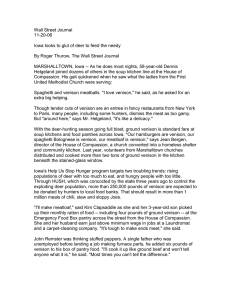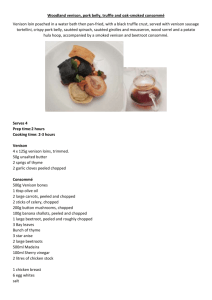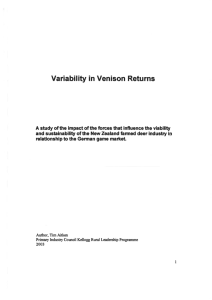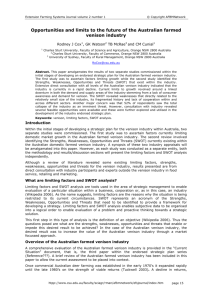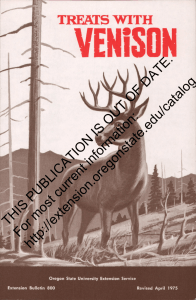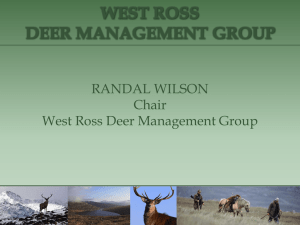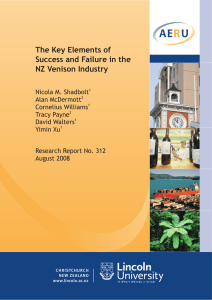Duncan & Company - Deer Industry New Zealand
advertisement
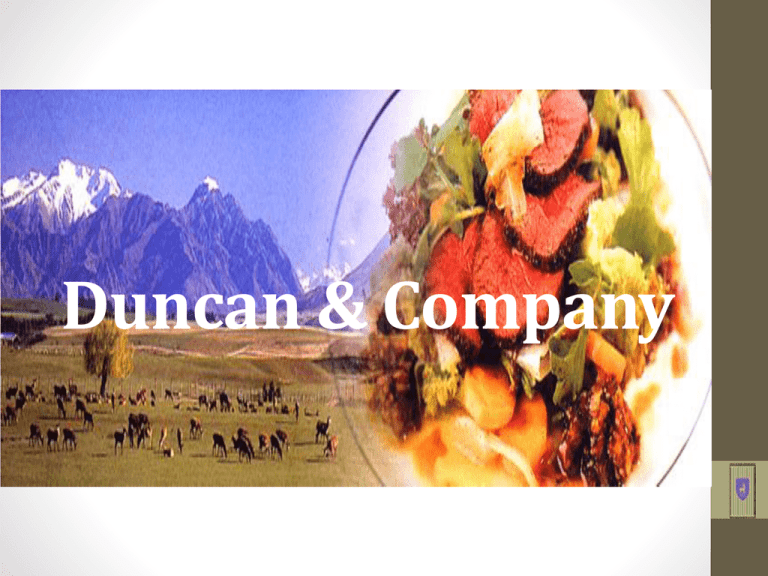
Duncan & Company Contents 1. Duncan & Co Introduction 2. Market Case Study: Germany cf Non-Europe 3. Industry Profitability 4. Summary/Conclusions Duncan & Company • Established in 1990- 24 years in business • Venison specialists • National coverage Sales • New Zealand- 2% • Asia- 8% • Balance –Europe/Nth America 50:50 Supply Contracts • All year round 12 month contracts - Indexed to the schedule to reflect market and competitive conditions - Bonuses paid for commitment, loyalty, off season supply and performance Yield Scoring • Yield research trials show over $1.00/kg variation between best and worst yielding stock • Individual deer yield scored to enable more accurate pricing of deer and valuable breed selection feedback for farmer Case Study : Germany vs Non-Europe Europe - Volume dropping - Price premium over other sources reducing German Market Why? - 2011 research findings back up research of 20 yrs ago - Traditional consumers want : • strong gamey taste, not mild. • local source of supply, not imported • traditional recipe, not modern cuisine • traditional rustic restaurant décor and setting. …those traditional consumers will try venison from other sources, but its not their preference. They’ll try imported, if there's none other available, or if its cheaper. Quality is not critical, due to cut used and cooking method. German Market- cont. • If we want a premium, our target market is NOT the Traditional game consumer, but the Non-game consumer, but there are some Hurdles: 1. Pre-conceived notions re taste 2. Doubts re the farming of game 3. Issues re distance to the market, ( shelf life, fuel cost, carbon emissions) …which all make Germany a harder place to launch a premium farmed game item than other markets where there are no preconceptions. Non-European Market Development over 20 years Leg/Loin Items 6 5 4 3 Leg/Loin Items 2 1 0 1993 2003 2013 Non-European Market Development (cont’d) Shoulder 3.5 3 2.5 2 Shoulder 1.5 1 0.5 0 1993 2003 2013 Non-European Market Development (cont’d) Trim 7 6 5 4 Trim 3 2 1 0 1993 2003 2013 Non-European Market Development • Loin/leg items volumes dropped since 2008 GFC, but recovering. • Shoulder and Trim items growth due to: 1. Lack of directly competing products 2. New product Innovation: - On-shore, in the NZ plants - Off-shore, at specialty processor level - At restaurant level, where Chefs are increasingly creating high end dishes, using lower priced, forequarter cuts. Deer Industry Profitability - Venison needs to be more profitable for both Farmer and Exporter/Processor - Deer farming profitability driven by: 1. Off shore market prices 2. On farm cost efficiencies 3. Exchange rates • NZ Dairy Industry’s competitive advantage built on NZ being lowest cost producer with high level of food safety integrity • NZ Deer Industry is not the lowest cost producer of venison so we need to achieve higher sale prices Market Pricing Upward Forces • • • • Promotion Supply shortage High wealth consumers Differentiation ( lack of competing alternatives) Downward Forces • Lack of promotion • Over supply • Financially stressed consumers • Undifferentiated product ( plentiful choice of competing alternatives) Comparison of Germany with Non-European markets Differentiation/lack of competing alternatives Germany • Low Differentiation • Most NZ venison items sold to Europe available from other sources e.g.- Spain, Scotland, Eastern Europe Non-Europe • High Differentiation • Most venison items sold NOT available from other sources Other Constraints On Price Chef vs Consumer • Chef: (purchasing for the restaurant) - Venison is an ingredient in a meal prepared by the Chef - Restaurant is a business therefore food cost is a business decision the chef wants good quality but not necessarily the very best quality - Price is critical - A premium is achievable but only small premium Other Constraints On Price • Consumer (purchasing for the home) - Venison is an ingredient in the meal prepared at home - If the occasion is special the venison purchase may be an emotional one (not a business decision) - The Moet vs Lindauer decision - To create the premium positioning requires substantial demand creation at consumer level - Product form and distribution logistics are critical factors Conclusions We need better production ON farm, and better prices from the market. To get better Market prices: • Go to the Markets where there is least price competition with similar alternatives • Go to the markets where the product can be differentiated. • Target buyers who are prepared to pay a premium price Thank you. Duncan & Company
